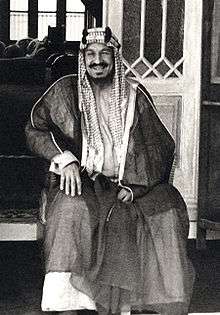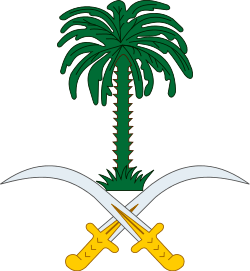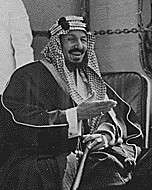Ibn Saud
Abdulaziz ibn Abdul Rahman ibn Faisal ibn Turki ibn Abdullah ibn Muhammad Al Saud (Arabic: عبد العزيز بن عبد الرحمن آل سعود, ‘Abd al-‘Azīz ibn ‘Abd ar-Raḥman Āl Sa‘ūd; 15 January 1875[1] – 9 November 1953), usually known within the Arab world as Abdulaziz[2] and in the West as Ibn Saud,[3] was the first monarch and founder of Saudi Arabia, the "third Saudi state".[4]
He reconquered his family's ancestral home city of Riyadh in 1902, starting three decades of conquests that made him the ruler of nearly all of central Arabia. He consolidated his control over the Najd in 1922, then conquered the Hejaz in 1925. He extended his dominions into the Kingdom of Saudi Arabia in 1932. As King, he presided over the discovery of petroleum in Saudi Arabia in 1938 and the beginning of large-scale oil production after World War II. He fathered many children, including 45 sons,[5] and all of the subsequent kings of Saudi Arabia.
Early life and family origins
Ibn Saud was born on 15 January 1875 in Riyadh in the region of Najd in central Arabia.[6][7] He was the son of Abdul Rahman bin Faisal, last ruler of the Emirate of Nejd, the "Second Saudi State", a tribal sheikhdom centered on Riyadh. His family, the House of Saud, had been a power in central Arabia for the previous 130 years. Under the influence and inspiration of Wahhabi Islam, the Saudis had previously attempted to control much of the Arabian peninsula in the form of the Emirate of Diriyah, the "First Saudi State", until its destruction by an Ottomon army in the Ottoman–Wahhabi War in the early nineteenth century.[8] Ibn Saud's mother was a member of the Sudairi family,[9] Sarah Al Sudairi.[10] She died in 1910.[11]
In 1890, the House of Saud's long-term regional rivals, the Rashidis, conquered Riyadh. Ibn Saud was 15 at the time.[12] He and his family initially took refuge with the Al Murrah, a Bedouin tribe in the southern desert of Arabia. Later, the Al Sauds moved to Qatar and stayed there for two months.[13] Their next stop was Bahrain, where they stayed briefly. Their final destination was Kuwait, where they lived for nearly a decade.[13]
In the spring of 1901, Ibn Saud and some relatives, including a half-brother, Mohammad, and several cousins, set out on a raiding expedition into the Najd, targeting for the most part tribes associated with the Rashidis. As the raid proved profitable, it attracted more participants. The raiders' numbers peaked at over 200, but numbers dwindled over the ensuing months.
In the autumn, the group made camp in the Yabrin oasis. While observing Ramadan, he decided to attack Riyadh and retake it from the Al Rashid. On the night of 15 January 1902, he led 40 men over the walls of the city on tilted palm trees and took the city.[14] The Rashidi governor of the city, Ajlan, was killed in front of his own fortress. The Saudi recapture of the city marked the beginning of the Third Saudi State.
Rise to power
Following the capture of Riyadh, many former supporters of the House of Saud rallied to Ibn Saud's call to arms. He was a charismatic leader and kept his men supplied with arms. Over the next two years, he and his forces recaptured almost half of the Najd from the Rashidis.
In 1904, Abdulaziz of Al Rashid appealed to the Ottoman Empire for military protection and assistance. The Ottomans responded by sending troops into Arabia. On 15 June 1904, Ibn Saud's forces suffered a major defeat at the hands of the combined Ottoman and Rashidi forces. His forces regrouped and began to wage guerrilla warfare against the Ottomans. Over the next two years, he was able to disrupt their supply routes, forcing them to retreat. The victory of Ibn Saud in Rawdat Muhanna, in which Abdulaziz died, ended the Ottoman presence in Najd and Qassim by the end of October 1906.
He completed his conquest of the Najd and the eastern coast of Arabia in 1912. He then founded the Ikhwan, a military-religious brotherhood, which was to assist in his later conquests, with the approval of local Salafi ulema. In the same year, he instituted an agrarian policy to settle the nomadic pastoralist Bedouins into colonies and to replace their tribal organizations with allegiance to the Ikhwan.
During World War I, the British government established diplomatic relations with Ibn Saud. The British agent, Captain William Shakespear, was well received by the Bedouin.[15] Similar diplomatic missions were established with any Arabian power who might have been able to unify and stabilize the region. The British entered into a treaty in December 1915 (the "Treaty of Darin") which made the lands of the House of Saud a British protectorate and attempted to define the boundaries of the developing Saudi state.[16] In exchange, Ibn Saud pledged to again make war against Ibn Rashid, who was an ally of the Ottomans.
The British Foreign Office had previously begun to support Sharif Hussein bin Ali, Emir of the Hejaz by sending T.E. Lawrence (a.k.a. Lawrence of Arabia) to him in 1915. The Saudi Ikhwan began to conflict with Hussein, Sharif of Mecca also in 1917 just as his sons Abdullah and Faisal entered Damascus. The Treaty of Darin remained in effect until superseded by the Jeddah conference of 1927 and the Dammam conference of 1952 during both of which Ibn Saud extended his boundaries past the Anglo-Ottoman Blue Line. After Darin, he stockpiled the weapons and supplies which the British provided him, including a 'tribute' of £5,000 per month.[17] After World War I, he received further support from the British, including a glut of surplus munitions. He launched his campaign against the Al Rashidi in 1920; by 1922 they had been all but destroyed.
The defeat of the Al Rashidi doubled the size of Saudi territory because after the war of Ha'il, Ibn Saud sent his army to occupy Al-Jouf and the army led by Eqab bin Mohaya, the head of Talhah tribe. This allowed Ibn Saud the leverage to negotiate a new and more favorable treaty with the British. Their treaty, signed at Uqair in 1922, where he met Percy Cox, British High Commissioner in Iraq, to draw boundaries[18] saw Britain recognize many of his territorial gains. In exchange, Ibn Saud agreed to recognize British territories in the area, particularly along the Persian Gulf coast and in Iraq. The former of these were vital to the British, as merchant traffic between British India and United Kingdom depended upon coaling stations on the approach to the Suez Canal.
In 1925, the forces of Ibn Saud captured the holy city of Mecca from Sharif Hussein, ending 700 years of Hashemite rule. On 8 January 1926, the leading figures in Mecca, Madina and Jeddah proclaimed Ibn Saud the King of Hejaz.[19] On 20 May 1927, the British government signed the Treaty of Jeddah, which abolished the Darin protection agreement and recognized the independence of the Hejaz and Najd with Ibn Saud as its ruler.
With international recognition and support, Ibn Saud continued to consolidate his power. By 1928, his forces had overrun most of the central Arabian Peninsula. However, the alliance between the Ikhwan and the Al Saud collapsed when Ibn Saud forbade further raiding. The few portions of central Arabia not under Saudi control had treaties with London. This did not sit well with the Ikwhan, who had been taught that all non-Wahhabis were infidels. Tensions finally boiled over when the Ikwhan rebelled in 1927. After two years of fighting, they were suppressed by Ibn Saud in the Battle of Sabilla in March 1929.
On 23 September 1932, Ibn Saud united his dominions into the Kingdom of Saudi Arabia, with himself as its king.[20] He transferred his court to Murabba Palace from the Masmak Fort in 1938[21] and the palace remained his residence and the seat of government until his death in 1953.[22]
Ibn Saud had to first eliminate the right of his own father in order to rule, and then distance and contain the ambitions of his five brothers, particularly his oldest brother, Muhammad, who fought with him during the battles and conquests that had given birth to the state.[23]
Oil and the rule of Ibn Saud
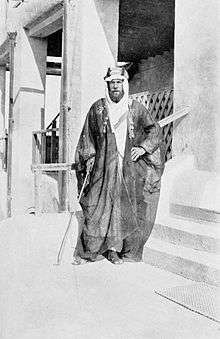
Petroleum was discovered in Saudi Arabia in 1938 by American geologists working for Standard Oil Company of New York (SOCONY) in partnership with Saudi officials. Through his advisers St John Philby and Ameen Rihani, Ibn Saud granted substantial authority over Saudi oil fields to American oil companies in 1944, much to the dismay of the British who had invested heavily in the House of Saud's rise to power in hopes of open access to any oil reserves that were to be surveyed. Beginning in 1915, he signed the "friendship and cooperation" pact with Britain to keep his militia in line and cease any further attacks against their protectorates for whom they were responsible.
His newfound oil wealth brought with it a great deal of power and influence that, naturally, Ibn Saud would use to advantage in the Hijaz. He forced many nomadic tribes to settle down and abandon "petty wars" and vendettas. He also began widespread enforcement of the new kingdom's ideology, based on the teachings of Muhammad Ibn Abd al-Wahhab. This included an end to traditionally sanctioned rites of pilgrimage, recognized by the orthodox schools of jurisprudence, but at odds with those sanctioned by Muhammad ibn Abd al-Wahhab. In 1926, after a caravan of Egyptians on the way to Mecca were beaten by his forces for playing bugles, he was impelled to issue a conciliatory statement to the Egyptian government. In fact, several such statements were issued to Muslim governments around the world as a result of beatings suffered by the pilgrims visiting the holy cities of Mecca and Medina. With the uprising and subsequent decimation thereafter of the Ikhwan in 1929 via British air power, the 1930s marked a turning point. With his rivals eliminated, Ibn Saud's ideology was in full force, ending nearly 1400 years of accepted religious practices surrounding the Hajj, the majority of which were sanctioned by a millennium of scholarship.
Ibn Saud established a Shura Council of the Hijaz as early as 1927. This Council was later expanded to 20 members, and was chaired by the king's son, Faisal.[24]
Foreign wars
Ibn Saud was able to gain loyalty from tribes near Saudi Arabia, tribes such as those in Jordan. For example, he built very strong ties with Prince Sheikh Rashed Al Khuzai from the Al Fraihat tribe, one of the most influential and royally established families during the Ottoman Empire. The Prince and his tribe had dominated eastern Jordan before the arrival of Sharif Hussein. Ibn Saud supported Prince Rashed and his followers in rebellion against the Hussein.[25]
Prince Rashed supported Izz ad-Din al-Qassam's defiance in 1935 which led him and his followers in rebellion against King Abdullah of Jordan. And later in 1937, when they were forced to leave Jordan, Prince Rashed Al Khuzai, his family, and a group of his followers chose to move to Saudi Arabia, where Prince Rashedi was living for several years in Ibn Saud's hospitality.[25][26][27][28]
Later years

Ibn Saud positioned Saudi Arabia as neutral in World War II, but was generally considered to favor the Allies.[29] However, in 1938, when an attack on a main British pipeline in the Kingdom of Iraq was found to be connected to the German Ambassador, Fritz Grobba, Ibn Saud provided Grobba with refuge.[30] It was reported that he had been disfavoring the British as of 1937.[31]
At the last stage of the war, Ibn Saud met significant political figures. One of these meetings, which lasted for three days, was with the U.S. President Franklin Delano Roosevelt on 14 February 1945.[32] The meeting took place on board of the USS Quincy at the Great Bitter Lake in the Suez Canal.[32][33] The meeting laid down the basis of the future relations between two countries.[34]
The other meeting was with British Prime Minister Winston Churchill in the Grand Hotel du Lac on the shores of the Fayyoun Oasis, fifty miles south of Cairo, in February 1945.[35] However, Saudis report that the meeting heavily focused on the Palestine problem and was unproductive in terms of its outcomes, in contrast to that with Roosevelt.[35]
In 1948, Ibn Saud participated in the Arab-Israeli War, but Saudi Arabia's contribution was generally considered token.[29]
While the members of the royal family desired luxuries such as gardens, splendid cars and concrete palaces, Ibn Saud wanted a royal railway from the Persian Gulf to Riyadh and then an extension to Jeddah. This was regarded by all of his advisers living in the country as an old man's folly. Eventually, ARAMCO built the railway, at a cost of $70 million, drawn from the King's oil royalties. It was completed in 1951 and was used commercially after the king's death. It enabled Riyadh to grow into a relatively modern city. But when a paved road was built in 1962, the railway lost its traffic.[36]
Personal life
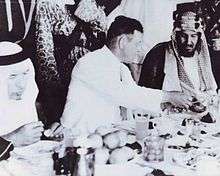
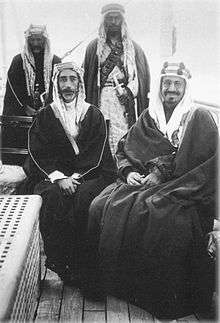
In accordance with the customs of his people, Abdul Aziz headed a polygamous household comprising several wives and concubines. According to some sources, he had twenty-two consorts. Many of his marriages were contracted in order to cement alliances with other clans, during the period when the Saudi state was founded and stabilized. Abdul Aziz was the father of almost a hundred children, including forty-five sons.
Relations with family members
Ibn Saud was said to be very close to his paternal aunt, Jawhara bint Faisal. From a young age, she ingrained in him a strong sense of family destiny and motivated him to regain the lost glory of the House of Saud. During the years when the Saud family were living almost as refugees in Kuwait, Jawhara bint Faisal frequently recounting the deeds of his ancestors to Abdulaziz and exhorted him not to be content in the existing situation. She was instrumental in making him decide to return to Najd from Kuwait and regain the territories of his family. She was well educated in Islam, in Arab custom and in tribal and clan relationships. All her life, she remained among the king's most trusted and influential advisors. Ibn Saud asked her about the experiences of past rulers and the historical allegiance and role of tribes and individuals. Jawhara was also deeply respected by the king's children. Ibn Saud used to visit her daily until she died around 1930.[37]
Ibn Saud was also very close to his sister Noura, who was one year older than him. On several occasions, he identified himself in public with the words: "I am the brother of Noura."[11][37] Noura died a few years before Ibn Saud.[11]
Assassination attempt
On 15 March 1935, armed men attacked and tried to assassinate Ibn Saud during his performance of Hajj.[38] He survived the attack unhurt.[38]
Successor
He appointed his second son Prince Saud heir to the Saudi Throne in 1933. He had many quarrels with his elder brother Muhammad bin Abdul Rahman as to whom should be appointed heir. Muhammad wanted his son Khalid to be designated the heir. His eldest son was Turki Al Awwal, who was the Crown Prince of the Kingdoms of Nejd and Hejaz, but unfortunately Turki died aged 18, and thus predeceased his father. After Turki, his younger full-brother was appointed Crown Prince. Had Turki not died, he would have been the Crown Prince. Ibn Saud had 45 sons out of which 36 managed to survive to adulthood. Ten of his sons were capable enough to be counted for succession. They were Saud, Faisal, Muhammad, Khaled, Fahd, Abdullah, Sultan, Nayef, Salman and Muqrin. Out of these ten only six became King. Muhammad, Sultan, Nayef and Muqrin couldn't become King. Muhammad resigned from the post of Crown Prince, Sultan and Nayef predeceased Abdullah, and Muqrin was removed from the post.
Views
In regard to essential values for the state and people, he said, "Two things are essential to our state and our people... religion and the rights inherited from our fathers."[39]
Amani Hamdan argues that the attitude of Ibn Saud towards women's education was encouraging since he expressed his support in a conversation with St John Philby in which he stated, "It is permissible for women to read."[40]
His last words to his two sons, the future King Saud and the next in line Prince Faisal, who were already battling each other, were "You are brothers, unite!"[23] Shortly before his death, Ibn Saud stated, "Verily, my children and my possessions are my enemies."[41]
Death and funeral
In October 1953, Ibn Saud was seriously ill due to heart disease.[42] He died in his sleep of a heart attack at the palace of Prince Faisal in Ta'if on 9 November 1953 (2 Rabīʿ al-Awwal 1373 AH) at the age of 78.[6][43][44] Prince Faisal was at his side.[44] Funeral prayer was performed at Al Hawiya in Ta'if.[6] His body was brought to Riyadh where he was buried in Al Oud cemetery.[6][45]
Reactions
The US Secretary of State John Foster Dulles stated after Ibn Saud's death that he would be remembered for his achievements as a statesman.[46]
Honors
In 1935, Ibn Saud was awarded the British Order of the Bath,[47] in 1947 the U.S. Legion of Merit and in 1952 the Spanish Order of Military Merit (with White Decoration).[48]
See also
- King of the Sands (2012 film) – a biopic film on Ibn Saud directed by Najdat Anzour
References
- ↑ His birthday has been a source of debate. It is generally accepted as 1875, although a few sources give it as 1880. According to British author Robert Lacey's book The Kingdom, a leading Saudi historian found records that show Ibn Saud in 1891 greeting an important tribal delegation. The historian reasoned that a nine or ten-year-old child (as given by the 1880 birth date) would have been too young to be allowed to greet such a delegation, while an adolescent of 15 or 16 (as given by the 1875 date) would likely have been allowed. When Lacey interviewed one of Ibn Saud's sons prior to writing the book, the son recalled that his father often laughed at records showing his birth date to be 1880. Ibn Saud's response to such records was reportedly that "I swallowed four years of my life."
- ↑ Robert Lacey (1982). The Kingdom. New York: Harcourt Brace Jovanovich. ISBN 0-15-147260-2.
- ↑ Ibn Saud, meaning son of Saud (see Arabic name), was a sort of title borne by previous heads of the House of Saud, similar to a Scottish clan chief's title of "the MacGregor" or "the MacDougall". When used without comment it refers solely to Abdul-Aziz, although prior to the capture of Riyadh in 1902 it referred to his father, Abdul Rahman (Lacey 1982, pp. 15, 65).
- ↑ Current Biography 1943, pp. 330–34
- ↑ "King Abdul Aziz family tree". Geocities. Retrieved 23 August 2013.
- 1 2 3 4 "The kings of the Kingdom". Ministry of Commerce and Industry. Retrieved 28 July 2012.
- ↑ David W. Del Testa, ed. (2001). "Saūd, Abdulaziz ibn". Government Leaders, Military Rulers, and Political Activists. Westport, CT: Oryx Press. p. 165. – via Questia (subscription required)
- ↑ "History of Arabia". Encyclopaedia Britannica Online. Retrieved 27 April 2014.
- ↑ Mordechai Abir (April 1987). "The Consolidation of the Ruling Class and the New Elites in Saudi Arabia". Middle Eastern Studies. 23 (2): 150–171. doi:10.1080/00263208708700697. JSTOR 4283169. Retrieved 25 April 2012.
- ↑ Fahd Al Semmari (Summer 2001). "The King Abdulaziz Foundation for Research and Archives". Middle East Studies Association Bulletin. 35 (1). JSTOR 23063369. – via JSTOR (subscription required)
- 1 2 3 "King Abdulaziz' Noble Character" (PDF). Islam House. Retrieved 29 April 2012.
- ↑ Wallace Stegner (2007). "Discovery! The Search for Arabian Oil" (PDF). Selwa Press. Retrieved 29 April 2012.
- 1 2 Mohammad Zaid Al Kahtani (December 2004). "The Foreign Policy of King Abdulaziz" (PDF). University of Leeds. Retrieved 21 July 2013.
- ↑ William Ochsenwald (2004). The Middle East: A History. McGraw Hill. p. 697. ISBN 0-07-244233-6.
- ↑ Robert Wilson and Zahra Freeth. The Arab of the Desert. London: Allen & Unwin, 1983. pp. 312–13. Print.
- ↑ Wilkinson, John C. Arabia's Frontiers: the Story of Britain's Boundary Drawing in the Desert. London u.a.: Tauris, 1993. pp. 133–39. Print
- ↑ Abdullah Mohammad Sind. "The Direct Instruments of Western Control over the Arabs: The Shining Example of the House of Saud" (PDF). Social Sciences. Retrieved 10 January 2013.
- ↑ Ibn Saud meets Sir Percy Cox in Uqair to draw boundaries
- ↑ Clive Leatherdale (1983). Britain and Saudi Arabia, 1925–1939: The Imperial Oasis. New York: Frank Cass and Company.
- ↑ Odah Sultan (1988). "Saudi–American Relations 1968–78: A study in ambiguity" (PDF). Salford University. Retrieved 23 April 2012.
- ↑ "Murabba Palace Historical Centre". Simbacom. Retrieved 22 July 2013.
- ↑ "Rebirth of a historic center". Saudi Embassy Magazine. Spring 1999. Retrieved 22 July 2013.
- 1 2 Mai Yamani (January–March 2009). "From fragility to stability: a survival strategy for the Saudi monarchy" (PDF). Contemporary Arab Affairs. 2 (1): 90–105. doi:10.1080/17550910802576114. Retrieved 5 April 2012.
- ↑ Anthony H. Cordesman (30 October 2002). "Saudi Arabia enters the 21st century: III. Politics and internal stability" (PDF). Center for Strategic and International Studies (CSIS). Retrieved 1 May 2012.
- 1 2 المجلة المصرية نون. "المجلة المصرية نون – سيرة حياة الأمير المناضل راشد الخزاعي". Noonptm. Retrieved 25 October 2011.
- ↑ "الشيخ عز الدين القسام أمير المجاهدين الفلسطينيين – (ANN)". Anntv. 19 November 1935. Retrieved 25 October 2011.
- ↑ "جريدة الرأي ; راشد الخزاعي.. من رجالات الوطن ومناضلي الأمة". Al Rai. Retrieved 25 October 2011.
- ↑ "مركز الشرق العربي ـ برق الشرق". Asharq Al Arabi. Retrieved 25 October 2011.
- 1 2 A Country Study: Saudi Arabia. Library of Congress Call Number DS204 .S3115 1993. Chapter 5. "World War II and Its Aftermath"
- ↑ Time Magazine, 26 May 1941
- ↑ Time Magazine, 3 July 1939
- 1 2 Rudy Abramson (9 August 1990). "1945 Meeting of FDR and Saudi King Was Pivotal for Relations". Los Angeles Times. Washington DC. Retrieved 22 July 2013.
- ↑ "President Roosevelt and King Abdulaziz". SUSRIS. 17 March 2005. Retrieved 22 July 2013.
- ↑ Gawdat, Bahgat (Winter 2004). "Saudi Arabia and the War on Terrorism". Arab Studies Quarterly. 26 (1). Retrieved 14 September 2013. – via Questia (subscription required)
- 1 2 "Ibn Saud meets British Prime Minister Winston Churchill". King Abdulaziz Information Resource. Retrieved 22 July 2013.
- ↑ Michel G. Nehme (1994). "Saudi Arabia 1950–80: Between Nationalism and Religion". Middle Eastern Studies. 30 (4): 930–943. doi:10.1080/00263209408701030. JSTOR 4283682. Retrieved 11 April 2012.
- 1 2 Stig Stenslie (2011). "Power behind the Veil: Princesses of House of Saud". Journal of Arabian Studies: Arabia, the Gulf, and the Red Sea. 1 (1): 69–79. doi:10.1080/21534764.2011.576050. Retrieved 15 April 2012.
- 1 2 Amin K. Tokumasu. "Cultural Relations between Saudi Arabia and Japan from the Time of King Abdulaziz to the Time of King Fahd". Darah. Retrieved 2 January 2013.
- ↑ Joseph Nevo (July 1998). "Religion and National Identity in Saudi Arabia". Middle Eastern Studies. 34 (3): 34–53. doi:10.1080/00263209808701231. JSTOR 4283951. Retrieved 5 April 2012.
- ↑ Amani Hamdan (2005). "Women and education in Saudi Arabia: Challenges and achievements" (PDF). International Education Journal. 6 (1): 42–64. Retrieved 22 April 2012.
- ↑ Steffen Hertog (2007). "Shaping the Saudi state: Human agency's shifting role in the rentier state formation" (PDF). International Journal Middle East Studies. 39: 539–563. doi:10.1017/S0020743807071073. Retrieved 17 April 2012.
- ↑ "Warrior King Ibn Saud Dies at 73". The West Australian. 10 November 1953. Retrieved 2 April 2013.
- ↑ Richard Cavendish (2003). "Death of Ibn Saud". History Today. 53 (11). Retrieved 29 July 2012.
- 1 2 "Ibn Saud dies". King Abdulaziz Information Source. Retrieved 9 August 2012.
- ↑ Abdul Nabi Shaheen (23 October 2011). "Sultan will have simple burial at Al Oud cemetery". Gulf News. Retrieved 29 July 2012.
- ↑ "Western tributes to King Ibn Saud". The Canberra Times. London. 11 November 1953. p. 5. Retrieved 11 April 2013.
- ↑ Saïd K. Aburish (15 August 2005). The Rise, Corruption and Coming Fall of the House of Saud: with an Updated Preface. Bloomsbury Publishing. p. 17. ISBN 978-0-7475-7874-1. Retrieved 11 August 2013.
- ↑ Boletín Oficial del Estado: Boletín Oficial del Estado (Spanish)
Further reading
- Michael Oren, Power, Faith and Fantasy: The United States in the Middle East, 1776 to the Present (Norton, 2007).
- Valentine, S. R., "Force & Fanaticism: Wahhabism in Saudi Arabia and Beyond", Hurst & Co, London, 2015, ISBN 978-1849044646
- The Egyptian magazine Noon. Cairo, Egypt – History of Prince Rashed Al-Khuzai with King Abdul Aziz Al Saud an article published by the American Writer Muneer Husainy & the Saudi Historian Khalid Al-Sudairy. 27 November 2009
- The political relationship between Prince Rashed Al-Khuzai, Sheikh Izz ad-Din al-Qassam, and Saudi Arabia Arab News Network, London – United Kingdom
- The political relationship between Prince Rashed Al-Khuzai and Sheikh Izz ad-Din al-Qassam, The Arab Orient Center for Strategic and civilization studies London, United Kingdom.
- DeNovo, John A. American Interests and Policies in the Middle East 1900–1939 University of Minnesota Press, 1963.
- Eddy, William A. FDR Meets Ibn Saud. New York: American Friends of the Middle East, Inc., 1954.
- Iqbal, Sheikh Mohammad. Emergence of Saudi Arabia (A Political Study of Malik Abd al-Aziz ibn Saud 1901–1953). Srinagar, Kashmir: Saudiyah Publishers, 1977.
- Robert Lacey (1982). The Kingdom. New York: Harcourt Brace Jovanovich. ISBN 0-15-147260-2.
- Long, David. Saudi Arabia Sage Publications, 1976.
- Miller, Aaron David. Search for Security: Saudi Arabian Oil and American Foreign Policy, 1939–1949. University of North Carolina Press, 1980.
- O'Sullivan, Christopher D. FDR and the End of Empire: The Origins of American Power in the Middle East. Palgrave Macmillan, 2012, ISBN 1137025247
- Alsabah – Formal Egyption magazine, Rashed Al Khuzai article. published in Cairo on 29 March 1938.
- Francis R. Nicosia (1985). The Third Reich and the Palestine Question. London: I. B. Taurus & Co. Ltd. p. 190. ISBN 1-85043-010-1.
- James Parry, A Man for our Century, Saudi Aramco World, January/February 1999, pp. 4–11
- Philby, H. St. J. B. Saudi Arabia 1955.
- Rentz, George. "Wahhabism and Saudi Arabia". in Derek Hopwood, ed., The Arabian Peninsula: Society and Politics 1972.
- Amin al-Rihani. Ibn Sa'oud of Arabia. Boston: Houghton–Mifflin Company, 1928.
- Sanger, Richard H. The Arabian Peninsula Cornell University Press, 1954.
- Benjamin Shwadran, The Middle East, Oil and the Great Powers, 3rd ed. (1973)
- Troeller, Gary. The Birth of Saudi Arabia:Britain and the Rise of the House of Sa'ud. London: Frank Cass, 1976.
- Twitchell, Karl S. Saudi Arabia Princeton University Press, 1958.
- Van der D. Meulen; The Wells of Ibn Saud. London: John Murray, 1957.
- Weston, Mark, Prophets and Princes – Saudi Arabia from Muhammad to the Present, Wiley, 2008
External links
| Wikiquote has quotations related to: Ibn Saud |
| Wikimedia Commons has media related to: |
- An article on his marriages and children (Arabic)
-
 "Ibn Sa'ud". Encyclopædia Britannica (12th ed.). 1922.
"Ibn Sa'ud". Encyclopædia Britannica (12th ed.). 1922.
| Ibn Saud House of Saud Born: 1876 Died: 1953 | ||
| Regnal titles | ||
|---|---|---|
| Preceded by Abd al-Aziz ibn Mut'ib |
Emir of Nejd 1902–1921 |
Succeeded by Himself as Sultan of Nejd |
| Preceded by Himself as Emir of Nejd |
Sultan of Nejd 1921–1927 |
Succeeded by Himself as King of Nejd |
| Preceded by Himself as Sultan of Nejd |
King of Nejd 1927–1932 |
Succeeded by Himself as King of Saudi Arabia |
| Preceded by Ali bin Hussein |
King of Hejaz 1926–1932 | |
| Preceded by Himself as King of Hejaz and Nejd |
King of Saudi Arabia 1932–1953 |
Succeeded by Saud |
| Preceded by Abdul Rahman bin Faisal Al Saud |
Head of the House of Saud 1901–1953 | |
